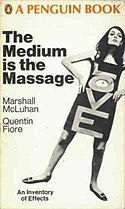The Medium is the Massage
From Wikipedia, the free encyclopedia
| This article does not cite any references or sources. Please help improve this article by adding citations to reliable sources. Unverifiable material may be challenged and removed. (December 2008) |
| The Medium is the Massage: An Inventory of Effects | |
 The cover of the first UK edition, published by Penguin Books (1967). |
|
| Author | Marshall McLuhan |
|---|---|
| Illustrator | Quentin Fiore |
| Country | UK |
| Language | English |
| Publisher | Penguin Books |
| Publication date | 1967 |
The Medium is the Massage: An Inventory of Effects is a book co-created by media analyst Marshall McLuhan and graphic designer Quentin Fiore, and coordinated by Jerome Agel. It was published by Bantam books in 1967 and became a bestseller and a cult classic.
The book itself is 160 pages in length and composed in an experimental, collage style with text superimposed on visual elements and vice versa. Some pages are printed backwards and are meant to be read in a mirror (see mirror writing). Some are intentionally left blank. Most contain photographs and images and historic, juxtaposed in startling ways.
The book was intended to make McLuhan's philosophy of media, considered by some incomprehensible and esoteric, more accessible to a wider readership through the use of visual metaphor and sparse text.
The book presaged the development of the original ARPANET by two years, and preceded the widespread civilian use of the Internet by almost twenty. For this and other reasons McLuhan is often hailed as a "prophet."
Contents |
[edit] Origin of the title
The book's title is actually a mistake according to McLuhan's son, Eric. The actual title was "The Medium is the Message" but it came back from the printer with the first "e" in message misprinted as an "a." McLuhan is said to have thought the mistake to be supportive of the point he was trying to make in the book and decided to leave it alone. Later readings have interpreted the word in the title as a pun meaning alternately "massage", "message", "mass age", or possibly "mess age". [1]
[edit] Summary
Marshall McLuhan argues in The Medium is the Massage that the dominant communication media of our time will shape the way humans think, act, and ultimately perceive the world around them. Technologies—from clothing to the wheel to the book, and beyond—are the messages themselves, not the content of the medium. In essence, The Medium is the Massage is a graphical and creative representation of his 'medium is the message' thesis seen in Understanding Media.
By playing on words and utilizing the term 'massage,' McLuhan is suggesting that modern audiences have found current media to be soothing, enjoyable, and relaxing; however, the pleasure we find in new media is deceiving, as the changes between society and technology are incongruent and are perpetuating an Age of Anxiety.
All media work us over completely. They are so pervasive in their personal, political, economic, aesthetic, psychological, moral, ethical, and social consequences that they leave no part of us untouched, unaffected, unaltered. (p. 26)
The Medium is the Massage demonstrates how modern media are extensions of human senses; they ground us in physicality, but expand our ability to perceive our world to an extent that would be impossible without the media. These extensions of perception contribute to McLuhan’s theory of the Global Village, which would bring humanity full circle to an industrial analogue of tribal mentality.
[edit] Related project
There is also an LP based on this book, put out by Columbia Records in the late 60s and produced by John Simon, but otherwise keeping the same credits as the book.
[edit] See also
[edit] Notes
- ^ "[...]the title was a mistake. When the book came back from the typesetter, it had on the cover "Massage" as it still does. The title should have read The Medium is the Message but the typesetter had made an error. When Marshall McLuhan saw the typo he exclaimed, "Leave it alone! It's great, and right on target!" Now there are four possible readings for the last word of the title, all of them accurate: "Message" and "Mess Age", "Massage" and "Mass Age"."Eric McLuhan in: Phil Baines. Penguin by Design, A Cover Story 1935-2005.Penguin Books.Pg 144

